Here is the list of 71 trees that are suitable to be grown as indoor bonsai trees. (Types of bonsai trees indoor with pictures)
Except for a few noteworthy exceptions, most of these species are tropical, subtropical, or Mediterranean, which makes them perfect for growing indoors in the conditions of an average home.
These bonsai trees come in a variety of leaf sizes, textures, and shapes, as well as bark types, from smooth to rough to scaly or peeling. Quite a few of the trees feature beautiful flowers followed by attractive fruits one or even several times a year.
*This list of indoor bonsai trees is arranged alphabatically.
1. Aleppo pine (Pinus halepensis) – aka Jerusalem pine

Hardiness zone : 8 – 11
Bonsai Styles : Formal upright, Informal upright, group, root over rock, slanting, semi-cascade, Literati
Country of Origin : Mediterranean
Aleppo pine comes from the Mediterranean and is one of the only two pine species that can be grown indoors. (Other pine that can be grown indoors is Australian Pine – discussed in later section).
In mature specimens, the trunk is furrowed and reddish brown, and the crown is sparse with twisting branches. Long, soft needles, up to 15cm (6in) in length, are arranged in pairs on the branches. The female flowers produce stalked, reddish brown cones.
A pinus halepensis bonsai can only be kept indoors under certain conditions. Every year, it must spend some time outside, and spend the winter below 50°F (10°C). A humidity level of 50% or more is necessary.
Please read Aleppo pine bonsai tree for a detailed guide on how to take care of this bonsai.
2. Asian star Jasmine (Trachelospermum asiaticum)
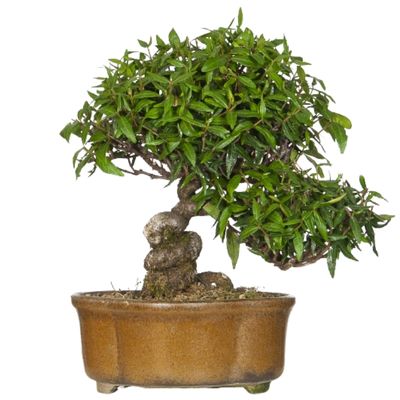
Hardiness zone : 7 – 11
Bonsai Styles : Informal Upright, cascade, semi-cascade
Country of Origin : South China and Japan
Asian star Jasmine is also called as Asiatic Jasmine, Chinese jasmine, Asian Jasmine.
Growing very rapidly, Trachelospermum asiaticum produces long, very thin stems. The stems are covered with delicate, shiny foliage that takes on a delightful diversity of colors throughout the year.
This is a robust semi-evergreen plant that is resistant to the sun and dryness.
The brilliant leaves, with a base color of beautiful medium green, will be splashed with red, yellow, orange, and rust with the passing of the seasons. Obviously, autumn offers the best display.
It is used to make fairly large bonsai because of its large leaves.
Please read Asian Star Jasmine bonsai tree for a detailed guide on how to take care of this bonsai.
3. Australian Pine (Casuarina equisetifolia) – aka horsetail tree

Hardiness zone : 9 – 11
Bonsai Styles : Informal upright, slanting, clump, multi-trunk, forest
Country of Origin : Australia, south Asia
Australian pine (aka Horsetail tree, mile tree, southsea ironwood) is a large, evergreen tree that grows along the sandy shores of the constantly humid tropics, from northern Australia to the Pacific islands to southeast Asia.
Due to its slender shape and foliage, this tree resembles a pine tree. Yet it is classified as deciduous, despite its pine needle-like leaves. The word Equisetifolia means “horsetail leaves” or “bristle leaf”.
Its upright pine needles mainly grow from the upper sides of the branches.
Australian Pine enables the bonsai enthusiast to grow a bonsai tree with needle-like foliage indoors. Since conifers like pine, juniper, and others don’t do well indoors.
Please read Australian Pine bonsai tree for a detailed guide on how to take care of this bonsai.
4. Australian umbrella tree (schefflera actinophylla / Heptapleurum actinophyllum)
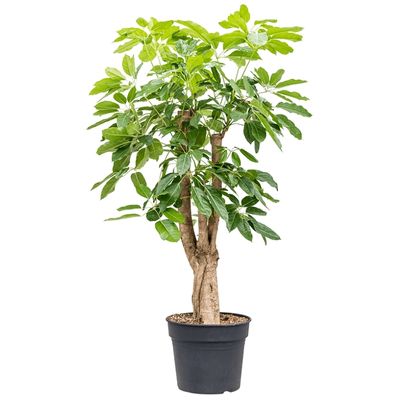
Hardiness zone : 10 – 12
Bonsai Styles : Informal upright, group, root over rock, clump
Country of Origin : Australia
An Australian and New Guinean native, this slow-growing evergreen tree bears alternate, divided leaves – palmate-compound with 5-7 oval segments. Known for its durability, Schefflera is a common houseplant.
Bonsai enthusiasts, however, may not find it suitable because of its large leaves and general lack of branch production. Training them to grow like European or Japanese trees is very difficult.
Another umbrella tree that can be used to grow as bonsai is – Hawaiian Umbrella tree.
Schefflera actinophylla can be kept in windows that do not receive direct sunlight.
Please read Australian umbrella tree bonsai for a detailed guide on how to take care of this bonsai.
5. Black Olive (Bucida molineti / Bucida Spinosa)

Hardiness zone : 10 – 12
Bonsai Styles : Informal upright, cascade, windswept
Country of Origin : North America, Caribbean
Black olive is a delicate tree from Florida and the Caribbean. Due to its tight growth habit and short, thin branches that change direction quite dramatically at the nodes, black olive lends itself well to bonsai.
There are small, dark blue-green leaves that are closely spaced.
Black olives tolerate salt well, so they make an great choice for bonsai enthusiasts who plan to grow their collections outdoors during the summer. Bright light is necessary indoors and outdoors.
Its flowers are cream-colored; its fruit starts out green and develops into a reddish brown color.
Please read Black Olive bonsai tree for a detailed guide on how to take care of this bonsai.
6. Blue Jacaranda (Jacaranda mimosifolia) – aka Jacaranda or Green ebony
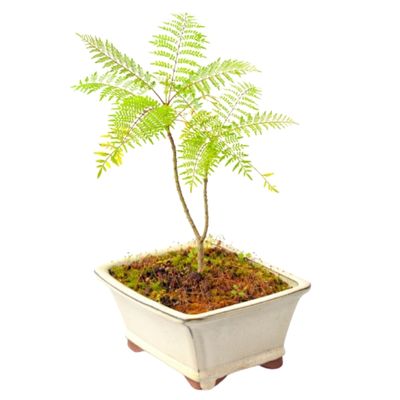
Hardiness zone : 10 – 11
Bonsai Styles : Informal upright, Slanting, clump, group, miniature landscape, semi-cascade, cascade, twin-trunk, multiple-trunk
Country of Origin : South America
Jacaranda is a small, tender, lime-hating, semi-evergreen shrub from Brazil. This tree can be found today in many subtropical regions.
This plant has long, cascading stems with pale green leaves – pairs of narrow leaflets. The flowers are blue-purple with white throats. This bonsai grown indoors rarely produces flowers, unfortunately.
Jacaranda bonsai is primarily grown indoors for its fern-like foliage rather than for its lovely blue-mauve flowers. Furthermore, only young specimens of this tropical flowering tree can be grown indoors. It needs light but not too much direct sun light.
It is the large, feathery leaves that pose the greatest challenge to bonsai growers. The leaves, however, can be reduced in size when the plant is located in the right place, watered, and fed properly.
Please read Jacaranda bonsai tree for a detailed guide on how to take care of this bonsai.
7. Brush Cherry (Syzygium paniculatum) – aka Australian brush cherry
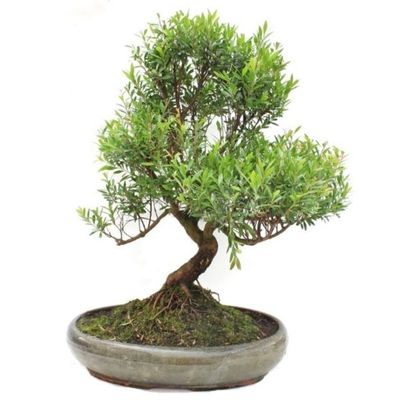
Hardiness zone : 6 – 12
Bonsai Styles : Informal upright, Forest style
Country of Origin : Australia & New Zealand
Known for its thin, elliptical, dark green, glossy leaves, brush cherry is a beautiful evergreen tree native to Australia. It produces abundant leaves that are perfect for bonsai of small to medium size.
During early summer, the flowers, similar to those on myrtles, grow in clusters at the tip of short woody shoots. These flowers are occasionally followed by red fruit resembling cherries. The small, egg-shaped fruits are edible.
As soon as the leaves on the young shoots receive sufficient light, they become fiery red, and surely add to the charm of this subtropical bonsai tree.
The cultivation of small-leafed brush cherry cultivars is especially popular for bonsai. It was previously known as Eugenia paniculata.
Please read Brush Cherry bonsai tree for a detailed guide on how to take care of this bonsai.
8. Common Camellia (Camellia japonica)
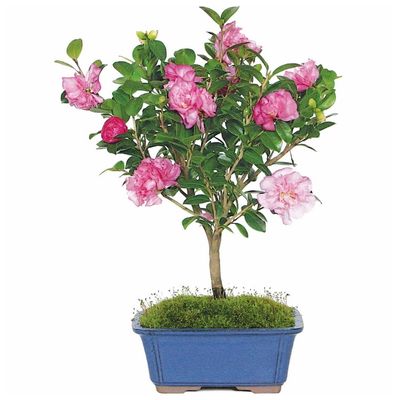
Hardiness zone : 6 – 10
Bonsai Styles : Informal upright, slanting, semi-cascade, cascade, twin-trunk, clump
Country of Origin : Japan and China
Common camellia trees (native to Japan, China, Korea and the Liu Kiu Islands) can also be grown indoors, though they are generally thought of as cold greenhouse or conservatory plants.
The plant is widely used as bonsai, particularly in Japan. It is a very beautiful plant. The deep green leaves make a striking contrast to the smooth gray-brown bark of the trunk.
Dark green, glossy leaves provide an attractive backdrop for the flowers — single- and double-flowered varieties — that are white through pink and red to purple.
It is a popular evergreen shrub that grows well in temperate regions, except for its flowers that are damaged by late-winter and early-spring frosts.
Please read Camellia bonsai tree for a detailed guide on how to take care of this bonsai.
9. Campeche (Haematoxylum campechianum) – aka bloodwood tree
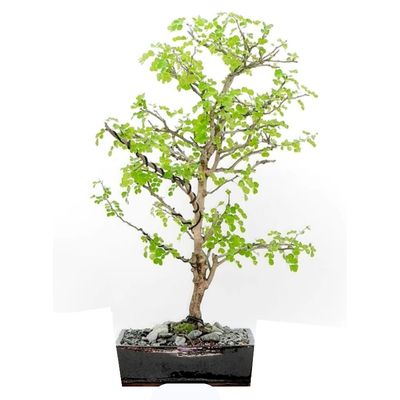
Hardiness zone : 10 – 11
Bonsai Styles : Informal upright, slanting, root-over-rock, twin-trunk, clump, multi-trunk, group
Country of Origin : Central and South America
Campeche also known as Logwood, bloodwood tree, campeachy, is an thorny evergreen bush that has prickly branches producing oval light green leaves. The leaves close as the light levels lower – as night approaches.
It has gnarled bark and produces small fragrant yellow inconspicuous flowers from its woody leaf axis. If grown outdoors in full sunlight, the new shoots will grow in fiery red color.
Bloodwood tree bonsai can be grown indoors. However, it only recommended to experienced bonsai growers because of its low tolerance to even slight neglect in care.
Please read logwood bonsai tree for a detailed guide on how to take care of this bonsai.
10. China rose (Hibiscus rosa-sinensis) – aka Chinese hibiscus

Hardiness zone : 6 – 9
Bonsai Styles : Informal upright, group, slanting, semi-cascade
Country of Origin : China
China rose, also known as rose of China, Chinese hibiscus, and Blacking plant, is an evergreen shrub from the tropics. It has oval dark green leaves and single deep crimson flowers. It blooms for a long period, from early summer to early fall.
The leaves of this spectacular tender climber are toothed and pointed.
Several varieties of these plants are available as pot plants, with flowers of different colors and shapes.
The rose of China is seldom cultivated as a bonsai due to its relatively large leaves. A large bonsai can be grown, however, so that its leaves are proportionately large.
It is mostly grown outdoors, however it is also suited to being grown as an indoor bonsai tree. It can be kept indoors the whole year.
Please read China rose bonsai tree for a detailed guide on how to take care of this bonsai.
11. Chinese Elm (Ulmus parvifolia)
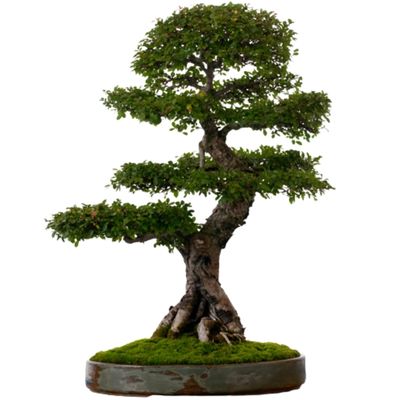
Hardiness zone : 5 – 9
Bonsai Styles : Informal upright, semi-cascade, cascade, twin trunk, broom
Country of Origin : China, Korea and Japan
A native of East Asia, Ulmus parvifolia is widely used in bonsai. This is a small deciduous tree. In comparison to most elm trees, it is quite small.
Its toothed leaves are oval or almost round and very small, making it ideal for bonsai cultivation. Also, the trunk of the tree has a natural basal flare.
While deciduous in cooler climates, it reveals its evergreen tendencies when its leaves linger at the end of the growing season.
A lot of light and sunshine is good for Ulmus parvifolia. Chinese elm bonsai should be positioned indoors in a bright place but out of the sun.
Please read Chinese elm bonsai tree for a detailed guide on how to take care of this bonsai.
12. Chinese Privet (ligustrum sinense)
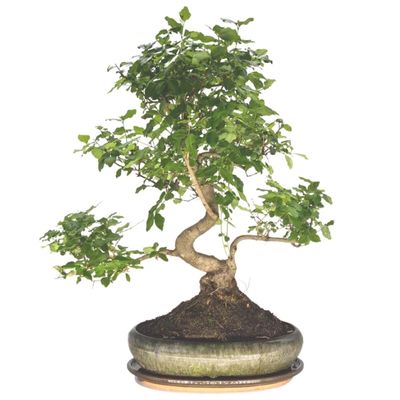
Hardiness zone : 7 – 11
Bonsai Styles : Informal upright, broom, slanting, root-over-rock, clasped-to-rock, twin-trunk, clump, group
Country of Origin : China, Korea and Japan
An arching shrub with elliptic-oblong pale green leaves, ligustrum sinense is a bushy, sometimes tree-like deciduous or semi-evergreen shrub. It is deciduous in excessively cold winters and evergreen in mild temperatures.
The other private variety – Ligustrum vulgare (common privet) – is NOT an indoor bonsai tree. Refer to common privet bonsai tree for more details.
The leaves are pale green and either lance-shaped or oval in shape. It produces white flowers in midsummer, followed by round, black-purple fruits that often persist through to the following year.
Chinese private is a strong grower and makes an excellent bonsai. It can thrive in poor soils, requiring few nutrients.
In cold climates, this bonsai can also be grown indoors.
Please read Chinese privet bonsai tree for a detailed guide on how to take care of this bonsai.
13. Chinese Yew (Podocarpus macrophyllus)
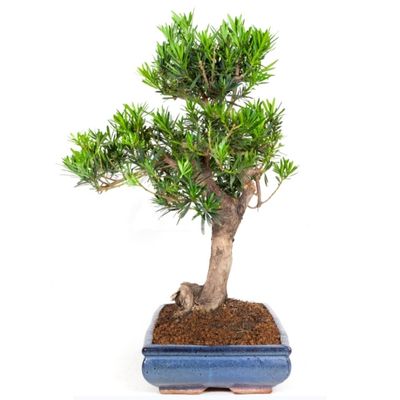
Hardiness zone : 7 – 10
Bonsai Styles : Informal upright, semi-cascade, cascade, slanting
Country of Origin : China and Japan
Chinese yew, also known as Chinese podocarpus or Big leaf, is an evergreen, dioecious (male and female flowers on separate trees) conifer, a native of southern Japan and southern China.
It is one of the conifer trees that are frequently grown as a bonsai.
This slow-growing conifer is mainly grown as a bonsai for its glossy leaves. The long, narrow, needle-like evergreen leaves are arranged in an attractive spirals.
The upright trunk is covered in reddish brown bark.
The podocarp thrives where the growing season is long, hot, and humid. There are male and female plants in the plant. Female trees produce edible red-purple fruit in the fall.
The plant needs full sun to partial shade. In hot climates, afternoon sunlight can scorch the needles.
Please read Chinese Yew bonsai tree for a detailed guide on how to take care of this bonsai.
14. Chinese Zelkova (zelkova sinica)

Hardiness zone : 6 – 9
Bonsai Styles : Informal upright, clump, group, raft,broom, slanting, semi-cascade
Country of Origin : China
Chinese zelkova tree originates from China and is regarded as tender temperate to sub-tropical.
In warm climates, this tree will remain evergreen, but in colder climates, it will drop its leaves.
The leaves are light to medium green and toothed at the edges. Normally, the trunk is smooth and gray brown in color.
Chinese zelkova is a very strong grower and is resistant to changes in growing conditions. Bonsai growers grow Chinese zelkova bonsai as both outdoor and indoor bonsai tree.
Important: Sometimes the term “zelkova sinica” is also WRONGLY used for elm trees from Korea and China. So be careful when buying a bonsai specimen or bonsai material. make sure that you are buying the right species.
Please read Chinese zelkova bonsai tree for a detailed guide on how to take care of this bonsai.
15. Common Guava (Psidium guajava)
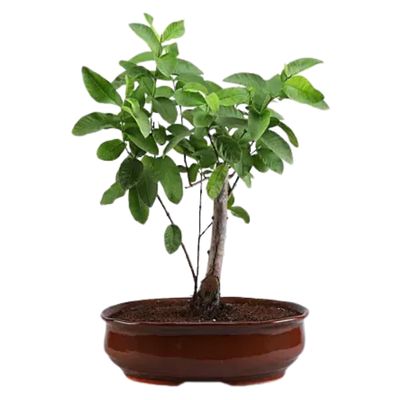
Hardiness zone : 9 – 11
Bonsai Styles : Informal upright
Country of Origin : Central and South America
Common guava, also known as yellow guava, lemon guava, or apple guava, originated in tropical regions of the Americas, but is now grown in almost all warm regions.
It has light to dark green bark that flakes quite often. Small pieces of bark are shed throughout the growing season. Its growth habit is similar to that of box trees.
White flowers are produced from the leaf axils, and it has opposite, oval leaves with a downy covering on the underside. There are many species of guava that can be used to make a bonsai tree: Psidium cattleianum (Strawberry Guava), Psidium guineese (Castilian guava).
Keep the guava bonsai tree in a bright spot when keeping it indoors.
Please read Common guava bonsai tree for a detailed guide on how to take care of this bonsai.
16. Common olive (Olea europaea)
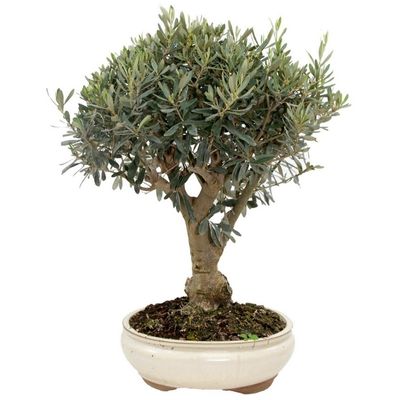
Hardiness zone : 9 – 10
Bonsai Styles : Informal upright, formal upright, broom, slanting, semi-cascade, twin trunk, multi-trunk, group
Country of Origin : Europe and Middle East
Olive europaea is a widely grown, slightly tender shrub or tree that has shiny, dark green, oval to lance-shaped leaves that have undersides that are light gray.
It has an attractive, light gray bark that becomes increasingly gnarled as it ages. This bonsai’s bark is one of its main features.
The light cream or off-white flowers are followed by green fruits which ripen from red to purple-black.
It also has a dwarf variety that can be grown as a bonsai – Olea europaea ‘Little Ollie’ – Dwarf Olive.
It is a sun-loving plant that can also be grown as an indoor bonsai tree. Keep it in a very bright location.
Please read Olive bonsai tree for a detailed guide on how to take care of this bonsai.
17. Cork Oak (Quercus suber)
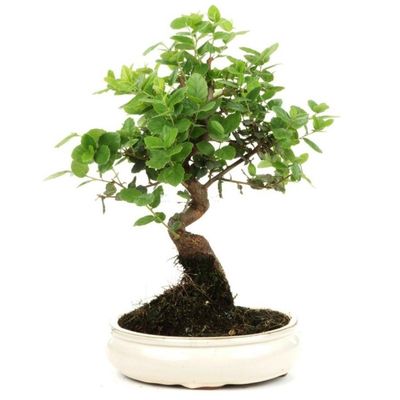
Hardiness zone : 8 – 11
Bonsai Styles : Broom style, Informal upright
Country of Origin : Europe
This is probably the most well-known oak from the Mediterranean region, and is cultivated primarily for its thick, rugged, corky bark.
Leaves are persistent, alternate, and simple, with a pointed tip, and are dark green above and gray-green below (closely resembling those of an evergreen oak, but less toothed). Fruit is a nut (acorn), partially protected by a hemispherical cup.
This knotty evergreen tree is highly recommended to make a delightful evergreen bonsai tree.
The plant needs a coldhouse climate. It is best to only collect young trees if you want to collect these trees, since older trees do not tolerate root pruning very well.
You must remember that the conditions in which it thrives best are difficult to reproduce. Provide plenty of sun and a cool, frost-free winter.
Please read Cork oak bonsai tree for a detailed guide on how to take care of this bonsai.
18. Crepe Myrtle (Lagerstroemia Indica)
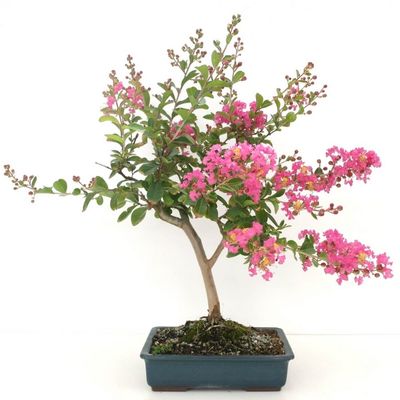
Hardiness zone : 7 – 10
Bonsai Styles : Informal upright, slanting, semi-cascade, root-over-rock
Country of Origin : China and Korea
Lagerstroemia Indica is a deciduous subtropical shrub that is native to Asia. Known for its abundant flowers, it is a popular plant.
The flowers are set together in large trusses and are white, pink or purple. When most other trees have finished flowering, these flowers appear quite late in the summer.
Oval and quite small, the dark green leaves have a glossy finish. The oval leaves are first red and later green and mauve. The grey-brown bark flakes off and is therefore very decorative, particularly in winter.
As long as it is placed in a bright position, it does reasonably well indoors. It is possible to expose it directly to the sun outdoors.
Please read Crepe Myrtle bonsai tree for a detailed guide on how to take care of this bonsai.
19. Cycad (Cycas)
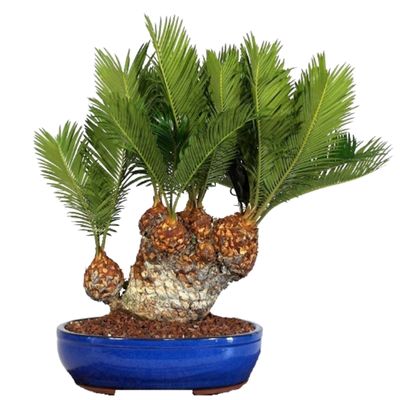
Hardiness zone : 8 – 13
Bonsai Styles : Clump, multiple-trunk, group, forest, broom, slanting
Country of Origin : China and Japan
Cycas is a primitive plant with a palm-like appearance native to China and Japan.
There are many varieties of Cycas that can be used to make a bonsai: Cycas revoluta (king sago or sago palm), Cycas circinalis (queen sago), and Cycas taigungensis (Prince sago). Out of all these varieties, Cycas revoluta is the most popular – One of the smallest species in the genus, and particularly prized.
Subligneous and cylindrical, the trunk ends in a bunch of fornicate leaves that are thick, glossy green, and leathery.
It grows well indoors in a bright position (south-facing window or west facing window), but avoid direct sunlight and spray the foliage regularly.
Please read Cycad bonsai tree for a detailed guide on how to take care of this bonsai.
20. Desert rose (Adenium obesum)

Hardiness zone : 11
Bonsai Styles : Clump
Country of Origin : Africa
Desert rose, also known as Impala lily, Kudu lily, mock azalea, Sabi star, is a succulent shrub with large pink flowers. It is more like a bush rather than a tree.
This succulent is a sparsely branching bush that grows in the dry desert region of East Africa. The plant has fleshy leaves that are directly attached to branch without a petiole.
It is relatively easy to transform this plant into a bonsai. It can be grown indoors without any problems.
Please read Desert rose bonsai tree for a detailed guide on how to take care of this bonsai.
21. Dwarf kumquat (Fortunella hindsii)
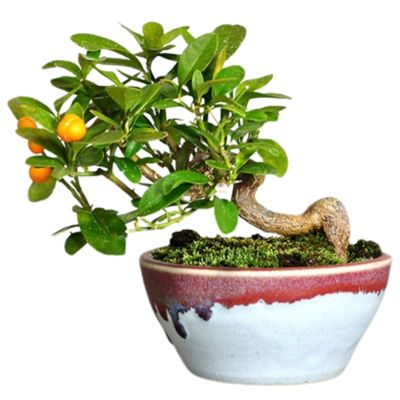
Hardiness zone : 8 – 10
Bonsai Styles : Informal upright, cascade, slanting
Country of Origin : China
Fortunella hindsii belongs to the citrus group (Rutaceae family) but bears golden-yellow fruits. It is also known as ‘dwarf orange‘ and ‘Hongkong kumquat‘.
The dwarf kumquat is an evergreen shrub native to Hong Kong and China with oval, glossy, deep green leaves and white fragrant small flowers.
Keep in mind that the plant will only produce flame orange colored flowers if it is exposed to high enough temperatures and humidity.
A smooth, brownish green bark with whitish stripes adds to the plant’s charm.
Apart from Fortunella hindsii, there are also other varieties of this species that can be used to grow as a bonsai: Fortunella margarita, Fortunella japonica.
Please read Dwarf kumquat bonsai tree for a detailed guide on how to take care of this bonsai.
22. Elephant bush (Portulacaria afra)
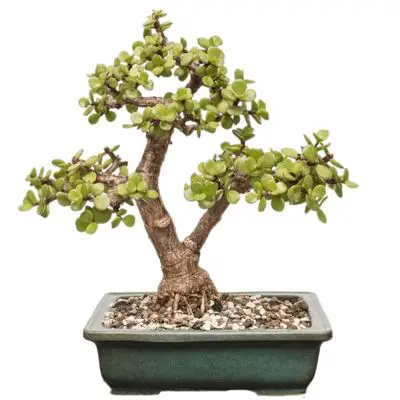
Hardiness zone : 9 – 11
Bonsai Styles : Informal upright, slanting, semi-cascade, broom, root over rock, group
Country of Origin : South Africa
Native to South Africa, this succulent grows as a shrub or small tree.
These near horizontal fleshy limbs carry opposite, thick, bright green leaves that contain tissues that store water.
In its native habitat it grows in arid areas and is said to be deciduous in times of drought.
It is often confused with Crassula ovata (Money or jade plant). These plants are different from each other.
Elephant bush requires little care. It is an easy to grow bonsai and can be grown indoors all year round.
Please read Elephant bush bonsai tree for a detailed guide on how to take care of this bonsai.
23. Elephant Tree (Bursera fagaroides)
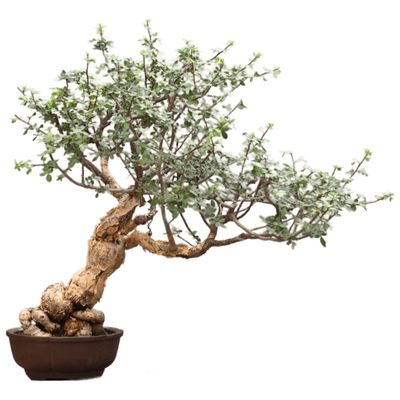
Hardiness zone : 10 – 11
Bonsai Styles : Informal upright, slant, wind swept
Country of Origin : Mexico
It is native to the deserts of northwestern Mexico and southern Arizona, where it thrives when temperatures are high during the day and cool at night.
Elephant Tree, also known as fragrant bursera, is a succulent shrub or small tree that makes great medium sized bonsai (chuhin).
An elephant tree has an attractive flaky bark and a light brown trunk with a stocky, swollen appearance. It has attractive small blue-green leaves.
Please read Elephant tree bonsai for a detailed guide on how to take care of this bonsai.
24. English Ivy (Hedera helix)
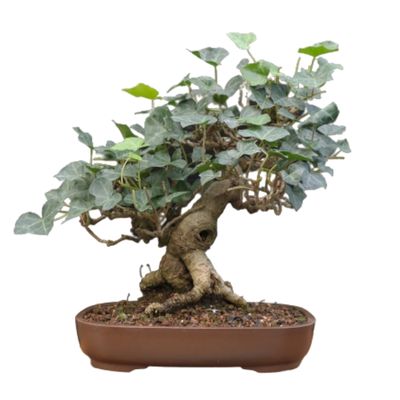
Hardiness zone : 5 – 11
Bonsai Styles : Cascade, informal upright, slant, semi-cascade, clump
Country of Origin : Europe
English Ivy is a typical climbing plant, with its main stem clinging to whatever support it is placed on with the help of small roots along the stem.
This woody vine also makes a versatile bonsai with its dark evergreen leaves and ridged trunk. The attractive leaves are glossy and leathery. Young leaves are dark green with contrasting light veins. On the other hand, older leaves are light green and have less noticeable veins.
A robust houseplant that tolerates cool and warm conditions equally well. English Ivy tolerates low light levels well, making it a suitable indoor bonsai tree.
One thing worth noting is that the tree will take quite some time to develop a thick trunk.
Please read English ivy bonsai tree for a detailed guide on how to take care of this bonsai.
25. Evergreen Ash (Fraxinus uhdei) – aka Shamel ash or tropical ash

Hardiness zone : 8 – 10
Bonsai Styles : Informal Upright, Forest
Country of Origin : Central America and Mexico
Unlike other ash varieties, this is the only ash bonsai tree that can be grown indoors. Rest of the ash varieties are outdoor bonsai trees.
It has slightly dropping branches and ash-grey bark. It has lance-shaped, shiny green leaves. Although this robust plant prefers a lot of light, it will also tolerate places with less light.
Please read Shamel ash bonsai for a detailed guide on how to take care of this bonsai.
26. Fig (Ficus)

Hardiness zone : Varies depending on the variety
Bonsai Styles : Informal upright, cascade, twin trunk, clump, Root over rock, exposed root, aerial root
Country of Origin : Varies depending on the variety (mostly southern Asia)
The Ficus genus is one of the most popular bonsai trees in indoor bonsai gardens and consists of kinds of evergreen trees, shrubs and woody climbers typically occurring in moist forests in tropical and subtropical areas of the world.
At least a dozen of these species and hundreds of varieties are suitable for growing bonsai.
A large reason for figs’ suitability for indoor growth is their tolerance for low humidity levels and low light levels that prevail in our centrally heated homes. As many Figs are native to forests, their tolerance for poor light is largely due to the shade provided by the forest canopy above.
The plant will, however, grow more vigorously if there is a higher level of humidity and light. To encourage strong growth, Ficus bonsai should be given as much light as possible.
Some ficus species that can be grown as a bonsai are:
Ficus neriifolia / Ficus salicifolia – Willow leaf ficus bonsai tree
Ficus religiosa – Sacred fig bonsai tree
Ficus natalensis – Natal fig bonsai tree
Ficus buxifolia / Ficus Lingua – Boxwood fig bonsai tree
Ficus benjamina – Weeping fig bonsai tree
Ficus carica – Common fig bonsai tree
Ficus microcarpa – Banyan tree bonsai tree (Green Island Ficus, Laurel fig, Indian Laurel)
Also read ficus bonsai tree care.
27. Firethorn (Pyracantha)
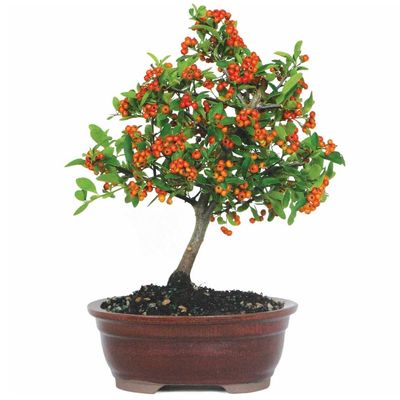
Hardiness zone : 6 – 9
Bonsai Styles : Informal upright, semi-cascade, cascade, twin trunk, broom, root-over-rock
Country of Origin : Europe, China
Firethorn is mostly grown as an outdoor bonsai, however, it can also be grown as an indoor bonsai tree when subjected to the right growing conditions.
Firethorn’s oval leaves have an attractive shine and are quite small, which makes the plant very attractive for bonsai.
A common evergreen shrub, it produces clusters of tiny cream flowers in spring and beautiful yellow, orange or red berries in the fall, that look gorgeous against the dark green leaves. Throughout the winter, these remain on the plant.
Firethorns grow fairly quickly and can handle heavy pruning well. All kinds of bonsai styles can be achieved with it, and it’s cheap and easy to maintain. In short it is the ideal plant for bonsai beginners.
Please read Firethorn bonsai tree for a detailed guide on how to take care of this bonsai.
28. Fuchsia (Fuchsia)
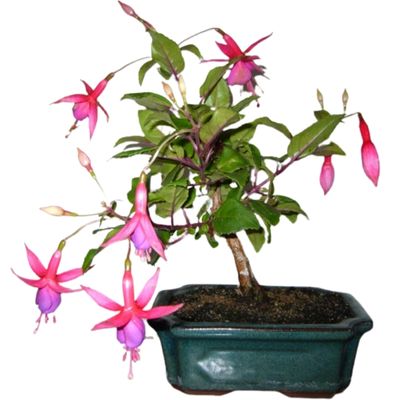
Hardiness zone : 8 – 9
Bonsai Styles : Groups, informal upright, formal upright, root-over-rock, root-in-rock, cascade
Country of Origin : New Zealand, Mexico, Central and South America
Fuchsias are subtropical hardy bushy shrub from South and Central America. Typically, they are used as window plants (often grown in boxes or hanging baskets).
Although the leaves of this deciduous genus vary in size and shape from species to species, they are typically lanceolate and arranged in opposite pairs.
Summer brings large numbers of the distinctive pendulous crimson and purple flowers, which arise from the axils of the terminal leaves.
Fuchsia loves living in my cool conservatory, where it is reluctant to shed the previous year’s leaves.
A fuchsia bonsai is a wonderful addition to the collection of anyone who has experience growing fuchsias as pot plants.
Please read Fuchsia bonsai tree for a detailed guide on how to take care of this bonsai.
29. Fukien tea (Carmona microphylla / Carmona retusa / Ehretia buxifolia)

Hardiness zone : 10
Bonsai Styles : Informal upright, formal upright, slanting, twin trunk, group, semi cascade, broom, raft, miniature landscape, literati
Country of Origin : China, Japan, Korea, Taiwan
A native of Asia, Fukien tea takes its name from a Chinese province. This evergreen shrub was previously known as Carmona microphylla, Carmona heterophylla, Ehretia buxifolia, and Ehretia microphylla.
It has small, glossy leaves organized in alternate groups of four, with three lobes at the tips and short, sturdy, light-colored hairs on the underside.
White flowers appear in the early summer, followed by red berries in the fall.
Its bark is also attractive after a few years, giving the tree the appearance of being quite old.
Commercially available varieties include the small-leaved C microphylla, usually sold only as young plants, and the larger-leaved C macrophylla with a thicker trunk. It is preferred to use the latter for bonsai, as it is more robust.
Please read Fukien tea bonsai tree for a detailed guide on how to take care of this bonsai.
30. Gardenia (Gardenia Jasminoides)
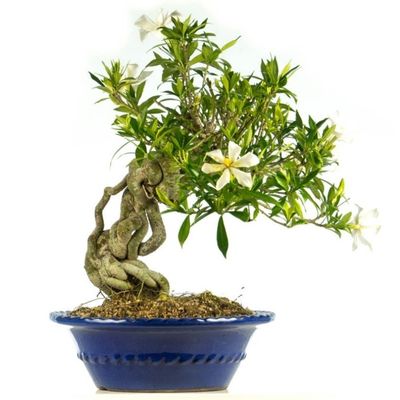
Hardiness zone : 9 – 11
Bonsai Styles : Informal upright, cascade, Slanting, Clump, Semi-cascade
Country of Origin : China
Gardenia, aka Cape Jasmine, was previously known as Gardenia augusta, Gardenia florida and Gardenia grandiflora. It is a tender evergreen shrub from China, Taiwan and Japan. It is regarded as tropical.
It is a richly-branching shrub with shiny, oval-shaped, dark green, leathery leaves. They are bright green on the upper side and pale green underneath.
It blooms profusely (at the leaf joints) in the spring with either a single six-pointed flower or a double flower. Sweet and highly fragrant, these flowers can almost overpower some people (especially the double flowered forms). Gardenias are known as winter-flowering pot plant.
Please read Gardenia bonsai tree for a detailed guide on how to take care of this bonsai.
31. Harland boxwood (Buxus harlandii)
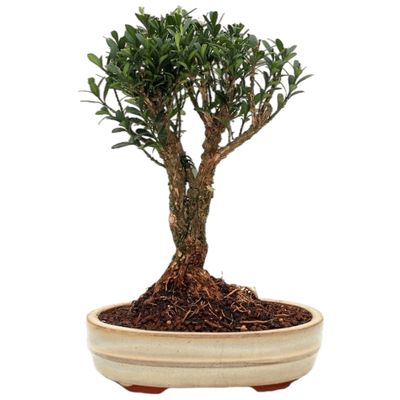
Hardiness zone : 7 – 9
Bonsai Styles : Formal upright, Informal upright, slanting, Literati, Root over rock, miniature landscape, clump, semi-cascade
Country of Origin : China
Buxus harlandii is native to southern China and Hong Kong. This slow-growing evergreen shrub needs warmth and protection when grown in temperate and cold climates.
It is a well-branched, robust shrub with small, shiny, dark green, leathery leaves.
It has a corky, deeply furrowed trunk, light beige in color. The yellowish-green flowers are inconspicuous but develop in large numbers.
It is sometimes confused with Buxus microphylla ‘Sinica’ or Buxus sinica. Hence, while buying your bonsai material, be sure that you are buying the right species.
When grown as a bonsai, it is considered a tender plant and can be easily killed or severely damaged by frost.
This tree species is not suitable for bonsai beginners and only experienced bonsai growers will be able to keep this bonsai alive for a long time indoors.
Please read Chinese boxwood bonsai tree for a detailed guide on how to take care of this bonsai.
32. Hawaiian Umbrella (Schefflera arboricola)

Hardiness zone : 6 – 9
Bonsai Styles : Informal upright, slanting, semi-cascade, cascade, root-over-rock, exposed root, clump
Country of Origin : Taiwan
It is also called Rubber Tree, Starleaf, and Hawaiian Elf Schefflera. It’s a slow-growing plant that also produces aerial roots. More experienced bonsai growers can use these aerial roots to their advantage while styling their bonsai tree.
In contrast to Schefflera actinophylla (Australian umbrella tree – native to tropical regions), Schefflera arboricola (Hawaiian umbrella tree) is native to sub-tropical regions.
Schefflera arboricola is much smaller than Schefflera actinophylla.
The plant has brilliant green palmate foliage in groups of seven or eight leaves. Its branches and trunk are highly flexible.
It is an easy-to-grow plant and is a recommended variety for bonsai beginners. It can be grown simply by planting it on a piece of volcanic rock that serves as a support. It can also survive occasional neglect.
Please read Hawaiian Umbrella bonsai tree for a detailed guide on how to take care of this bonsai.
33. Heavenly bamboo (Nandina domestica)

Hardiness zone : 7 – 10
Bonsai Styles : Informal upright, clump, twin trunk, group, landscape
Country of Origin : Japan
Heavenly bamboo, aka sacred bamboo, is an evergreen plant that has long compound leaves. These wide-spaced leaflets give it a bamboo-like appearance. Although evergreen, it will shed its leaves in cold weather. Hence, when grown as a bonsai treat it like sub-tropical rather than hardy.
Its bark gradually gains a mature appearance as it ages, and even quite young specimens will appear quite old. As Nandina is reluctant to branch from its trunk, it is usually planted in groups of multiple trunks.
This species is particularly attractive because its new leaves are tinged with red before turning green and finally purplish in autumn.
This plant has a long cluster of small white flowers that last for a long time, and it has an intensely red fruit that lasts for the entire winter. However, it is quite rare to see this plant bloom and bear fruit in a pot.
Please read Heavenly bamboo bonsai tree for a detailed guide on how to take care of this bonsai.
34. Holly oak (Quercus ilex)

Hardiness zone : 7 – 10
Bonsai Styles : Informal upright, clump, twin trunk, group, landscape
Country of Origin : Mediterranean
It is also known as holm oak or evergreen oak. Holly oaks grow all around the Mediterranean and live for a very long time.
When a tree is young, its bark is gray and smooth. Later, it breaks up into small plaque-like squares. Leaves are alternate, leathery, and toothed.
The fruit is an elongated acorn, protected about half-way by a cupola consisting of small triangular scales.
Please read Holm oak bonsai for a detailed guide on how to take care of this bonsai.
35. Italian stone pine (Pinus pinea)
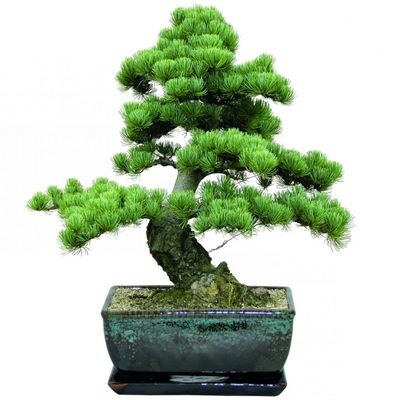
Hardiness zone : 7 – 10
Bonsai Styles : Informal upright, clump, twin trunk, group, landscape
Country of Origin : Mediterranean
Also known as Stone pine, Umbrella pine, or Mediterranean stone pine, Italian stone pine is one of the most common pines in the Mediterranean region.
Umbrella pine along with Aleppo pine are the only pine species that can be grown as an indoor bonsai tree. Provide them with a cool environment in the winter months.
It has a dense umbrella-like crown packed with pairs of dark green needles; they are light green when the tree is young. The barks of old trees exhibit orange, red and yellow-brown colors and have deep vertical fissures.
A few conifers, including Pinus pinea, can tolerate centrally heated environments at least temporarily.
Please read Italian stone pine bonsai tree for a detailed guide on how to take care of this bonsai.
36. Jaboticaba (Myrciaria cauliflora)
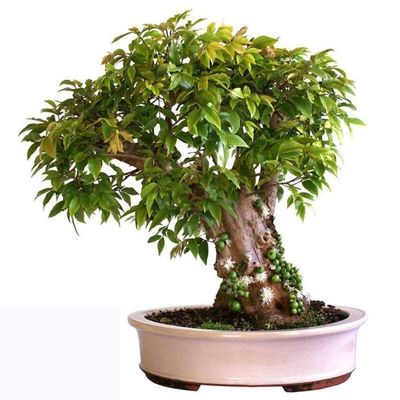
Hardiness zone : 9 – 11
Bonsai Styles : Informal upright, clump, twin trunk, group, forest, broom
Country of Origin : South America
A native of Brazil, Jaboticaba is a small, slow-growing tree. An evergreen fruiting tree, its bark flakes off in large patches, giving it a mottled appearance reminiscent of a tree.
Its beautiful two-toned peeling bark and pale salmon-colored new growth, which turns into light-green leaves, have given rise to its recent popularity and availability for use as an indoor bonsai specimen.
The trunk is well branched, and the limbs are irregular, light brown in color, and bear opposite, ovoid to lanceolate leaves with smooth edges.
A cluster of white flowers grows directly on the trunk and branches and matures into edible, grape-like fruits. Its small leaves and irregular growth pattern make it a popular indoor bonsai plant.
Please read Jaboticaba bonsai tree for a detailed guide on how to take care of this bonsai.
37. Jade (Crassula)
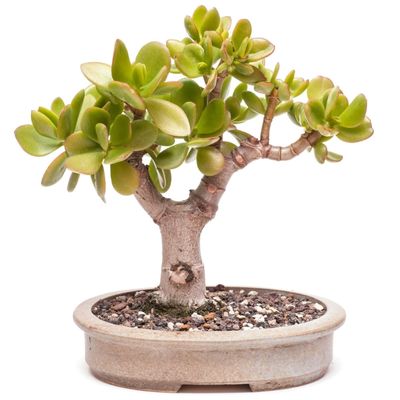
Hardiness zone : 10
Bonsai Styles : Informal upright, twin trunk
Country of Origin : South Africa
The plants of the Crassula genus are succulents that are native to semi-desert areas.
The variety most commonly used for bonsai is Crassula arborescens. However, there are other varieties as well that can be used to make bonsai – Crassula ovata (syn. Crassula portulacari).
The tree has a bulky growth habit. Leaves are opposite, often connate, not lobed, smooth and evergreen. It also produces flowers that can be pink, red or white in color.
It is capable of surviving even in the hottest conditions, and is unaffected by the cold conditions at night that occur in deserts either. Even a light frost won’t harm it.
Bonsai beginners, who have no knowledge of horticulture, can use this species to learn how plants grow and respond to pruning. As long as the roots are not allowed to become too wet, Crassula are virtually indestructible.
Please read Jade bonsai tree for a detailed guide on how to take care of this bonsai.
38. Japanese Boxwood (Buxus microphylla var. japonica)
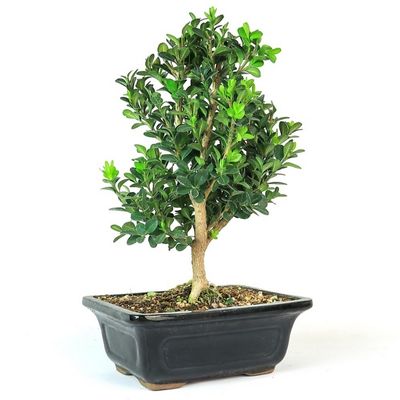
Hardiness zone : 6 – 9
Bonsai Styles : Informal upright, clump style
Country of Origin : Japan
Japanese boxwood bonsai can be grown outdoors and indoors. It is one of the few temperate cold-hardy plants that do well as indoor bonsai.
Light green leaves are rounded and dense. Occasionally, Japanese boxwood flowers, but it’s rare. There are small, yellow flowers that are inconspicuous.
Because of its small, tight growth and ability to thrive in containers, this evergreen shrub is excellent for both large and small bonsai.
Please read Japanese Boxwood bonsai tree for a detailed guide on how to take care of this bonsai.
39. Japanese Holly (Ilex crenata)
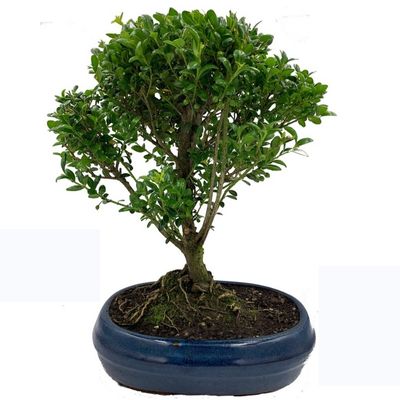
Hardiness zone : 6 – 8
Bonsai Styles : Informal upright, clump style, broom
Country of Origin : Japan and Korea
Japanese holly also known as Japanese evergreen holly or box-leaved holly, is a low-growing holly species with glossy, dark green, oval-shaped, small leaves.
This deciduous tree has an upright habit, with a large number of branches. The leaves turn anything from yellow, through orange to red in autumn.
In summer it produces small white flowers, and these are followed by black berries.
Indoors, as long as they are kept reasonably cool, they are reliable and easy to maintain. The holly is most suited to the informal upright and cascading styles.
Please read Japanese Holly bonsai tree for a detailed guide on how to take care of this bonsai.
40. Japanese pepper (Zanthoxylum piperitum)
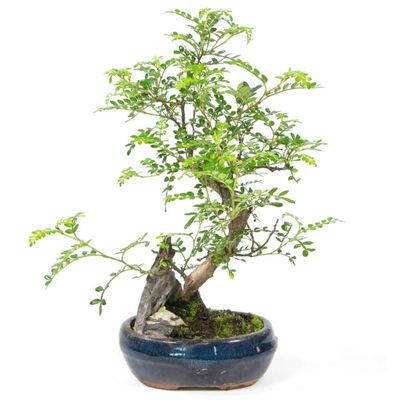
Hardiness zone : 7 – 10
Bonsai Styles : Informal upright
Country of Origin : Japan and China
Japanese pepper is a hardy deciduous plant. It has glossy, dark green, pinnate leaves that turn yellow in autumn.
Early in the summer, the plant produces greenish-yellow flowers, which are followed by tiny red berries. Its aromatic bark is slightly rough and brownish-gray.
While it was only recently introduced to the West as a bonsai, it is becoming more popular as an indoor bonsai tree that is easy to care for.
Please read Japanese pepper bonsai tree for a detailed guide on how to take care of this bonsai.
41. Japanese Privet (Ligustrum japonicum)

Hardiness zone : 7 – 10
Bonsai Styles : Informal upright, broom, slanting, root-over-rock, clasped-to-rock, twin-trunk, clump, group, broom
Country of Origin : Japan and Korea
The Japanese privet is an evergreen shrub native to Japan and Korea that is hardy in all climates but the harshest winters.
It bears lustrous, dark green, alternate, broad, egg-shaped leaves on its smooth branches. In mid- and late-summer, it also produces white flowers that are followed by black berries. Remember that these berries are poisonous.
However, Japanese privet is mostly grown as a bonsai for its beautiful shiny green foliage. Additionally, it is ideal for beginners who have little experience with bonsai.
Please read Japanese Privet bonsai tree for a detailed guide on how to take care of this bonsai.
42. Japanese snowbell (Styrax Japonica / Styrax Japonicus)

Hardiness zone : 5 – 8
Bonsai Styles : Informal upright, group, slanting, broom, semi-cascade
Country of Origin : Japan and Korea
The Japanese snowbell is a small and graceful deciduous tree, native to China, Korea, and Japan. It grows often in temperate climates. It is also known as Styrax japonicum or Styrax Japonica.
In autumn, its glossy, dark green leaves turn yellow or red. During early summer, fragrant, pinkish-white, bell-shaped flowers are followed by tiny aubergine-shaped fruits.
This beautiful flowering tree makes a fine indoor bonsai tree. It is easy to train these plants as bonsai and they are suitable for most styles of bonsai.
Please read Japanese snowbell bonsai tree for a detailed guide on how to take care of this bonsai.
43. Jasmine Orange (Murraya paniculata)

Hardiness zone : 9 – 11
Bonsai Styles : Informal upright, slanting, semi-cascade, cascade, twin trunk, clump, group
Country of Origin : Southern China and India
Orange jasmine is an evergreen, tree-like large shrub with deep green, unevenly pinnate leaves.
Trees native to tropical Asia – Indonesia, India, Philippines, and southern China – have smooth, yellow-brown trunks.
It produces highly fragrant 5-petalled white flowers that are arranged in clusters. There are only a few flowers that open at the same time in each cluster. As soon as these fade, the others open up.
These flowers are followed by long orange-red berries. Even though it does well indoors, it is best to keep it outside during the summer months.
Please read Jasmine Orange bonsai tree for a detailed guide on how to take care of this bonsai.
44. Kangaroo vine (Cissus antarctica / Cissus oblongata)
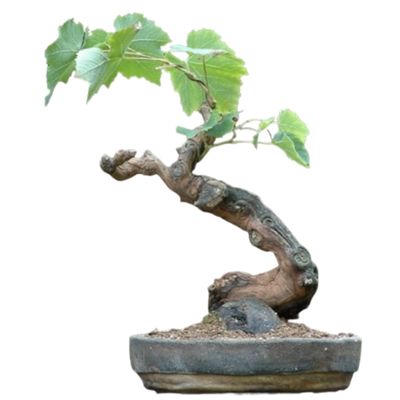
Hardiness zone : 10 – 12
Bonsai Styles : Informal upright, slanting, semi-cascade
Country of Origin : Australia
An easy-to-grow climber from Australia, the Kangaroo Vine also known as Australian vine has leathery green leaves which, when the plant is young, have a metallic sheen.
It is a fast-growing, well-branched, evergreen vine.
Kangaroo vine is a very robust plant that can tolerate temperature variations, so it is equally well suited to a warm or cool site.
Please read Kangaroo vine bonsai tree for a detailed guide on how to take care of this bonsai.
45. Kawista (Feroniella lucida)
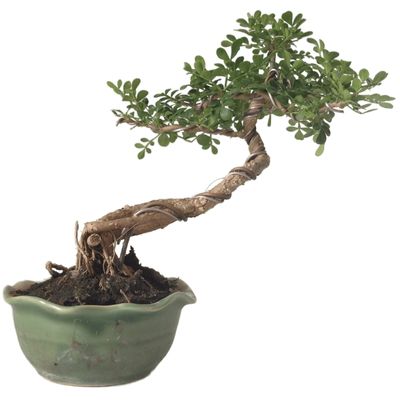
Hardiness zone : 8 – 9
Bonsai Styles : Informal upright, slanting, semi-cascade, cascade, clump
Country of Origin : Thailand
Feroniella lucida, also known as Kawista or Java cola, is native to Thailand. It is also known as the “long-life tree” as it lives for a long time. Its leaves are glossy, light green and feathery.
It has a rough bark and produces yellowish flowers. These flowers are followed by apple-like edible fruits. These fruits when ripe are covered with a hard brown colored shell.
Please read Kawista bonsai tree for a detailed guide on how to take care of this bonsai.
46. Lady palm (Rhapis humilis excelsa)

Hardiness zone : 9 – 11
Bonsai Styles : Informal upright, group
Country of Origin : Japan, China
Lady palm, also known as hemp palm or little lady palm or Slender lady palm, is not a typical tree. However, you can make an interesting indoor bonsai out of this plant.
It has a single stem and typical palm-like leaves. A dark, matt brown, woven cloth forms around the trunk of the palm as it grows.
Please read Lady palm bonsai tree for a detailed guide on how to take care of this bonsai.
47. Lantana (Lantana camara)

Hardiness zone : 10 – 11
Bonsai Styles : Root-over-rock, clump, semi cascade
Country of Origin : Central and South America
Lantana, also known as yellow sage or shrub verbena, is an evergreen shrub from tropical regions in the Americas often grown as a houseplant in temperate climates.
It is a small, colorful bush with its leaves alternately arranged on square branches. The oval leaves are pale to dark green in color and often too large for bonsai. Therefore, this plant is mainly suitable for making bonsai trees of medium to large size.
In the summer, dense clusters of domed heads of tubular flowers develop from leaf joints. The color of the flowers can range from red to orange to white. The color of the flowers changes as they age.
It also produces black colored berries. These berries are poisonous.
Please read Lantana bonsai tree for a detailed guide on how to take care of this bonsai.
48. Lavender star (Grewia occidentalis)
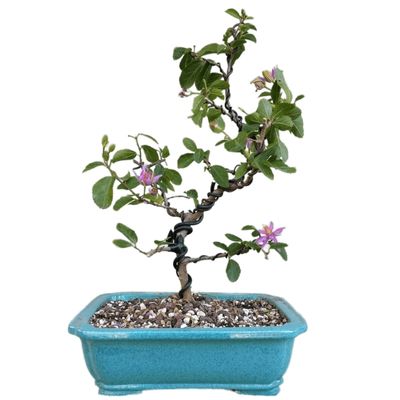
Hardiness zone : 9 – 11
Bonsai Styles : Informal upright, cascade
Country of Origin : Southern Africa
Lavender star is an evergreen shrub with small, tapering, shiny dark green leaves. It is a vigorous and fast-growing shrub that is native to Africa. About three times a year, it produces “star-like” mauve to purple flowers.
Occasionally these flowers are followed by berries – a compound fruit that is segmented into 4 sections. It is a low maintenance bonsai that is recommended for bonsai beginners.
Please read Lavender star bonsai tree for a detailed guide on how to take care of this bonsai.
49. Ming Aralia (Polyscias fruticosa)
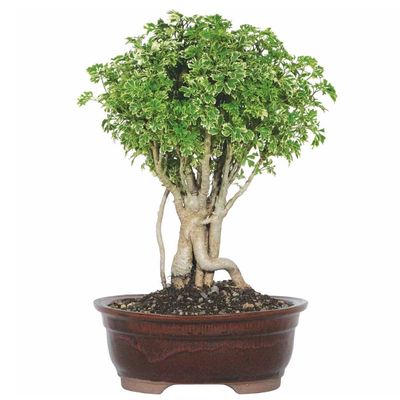
Hardiness zone : 11 – 12
Bonsai Styles : Informal upright, clump, group, over the rock, forest
Country of Origin : India
Ming aralia, also sometimes called as aralia ming, is found from India to the South Pacific. There is also another variety that can be used to make a bonsai – parsley aralia (Polyscias fruticosa ‘Elegans’).
It is an evergreen tropical shrub that has been grown as a potted house plant for a long time. It is also suitable for bonsai training.
Its leaves are long-stalked, pinnate and herbaceous. The pale green leaves have irregular deeply cut edges. It has woody branches with rough light beige/brown bark.
It is a slow-grower and has a really neat branching habit, making it even more suitable for making a unique bonsai tree.
Please read Ming Aralia bonsai tree for a detailed guide on how to take care of this bonsai.
50. Monterey cypress (Cupressus macrocarpa)

Hardiness zone : 7 – 11
Bonsai Styles : Broom, Formal Upright, Forest
Country of Origin : USA, Mediterranean, North Asia
Cypresses are conifers that have small, scaly, densely packed needles. The habit or growth pattern of this plant is broadly columnar when it is young. However, as the tree ages, its branches gain thickness and its crown becomes wider.
Monterey cypress bonsai trees are one of the few cypresses that can be grown indoors. (Other cypress that should be grown outdoors is Hinoki cypress bonsai).
The Monterey cypress are much better suited to be bonsai since they tolerate heat better indoors during the winter months.
If subjected to the right conditions indoors, this bonsai will thrive without the need for any special treatment. However, this plant is not suitable for bonsai beginners.
Please read Monterey cypress bonsai tree for a detailed guide on how to take care of this bonsai.
51. Myrtle (Myrtus)
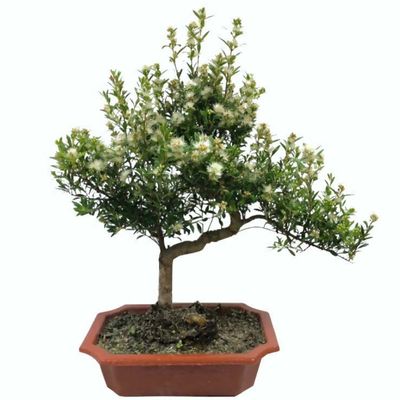
Hardiness zone : 9 – 10
Bonsai Styles : Informal upright, formal upright and groups
Country of Origin : Mediterranean, Europe, North Africa
Myrtus is an evergreen shrub found in the Mediterranean regions as well as in west Asia. It has opposite, lanceolate to ovate leaves that are tough and rich green in color.
Common myrtus species that are used for making bonsai trees are Myrtus communis and Myrtus apiculata. Myrtus communis makes an excellent cold room flowering bonsai with aromatic leaves. With age, the reddish-brown trunk becomes slightly furrowed.
In June, this bonsai begins to flower, and it can bloom until August. The flowers are white and are followed by purple to black fruits. Myrtle trees are very hardy and suitable for bonsai beginners.
Please read Myrtle bonsai tree for a detailed guide on how to take care of this bonsai.
52. Narrow-Leafed Bottlebrush (Callistemon linearis)
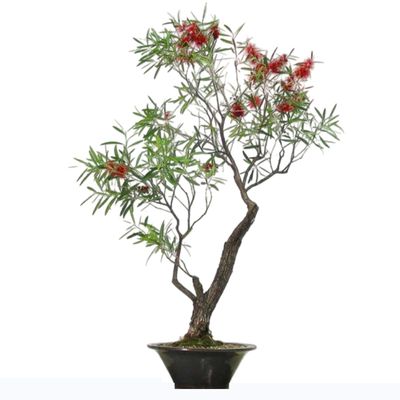
Hardiness zone : 10 – 11
Bonsai Styles : Formal upright, Informal upright, Slanting
Country of Origin : Australia
The Callistemon genus is native to Australia and has several species. These species have dark green leathery leaves.
As suggested by the name, the plant produces many delicate flower puffs that resemble the shape of a brush. A beautiful display of long cylinders of bright red clustered flowers is produced in late winter.
The corky bark of the tree is light brown and the narrow foliage is evergreen. Because of the size of the flowers, this plant is suitable for making a medium to large sized bonsai tree.
Please read Bottlebrush bonsai tree for a detailed guide on how to take care of this bonsai.
53. Natal Plum (Carissa macrocarpa)
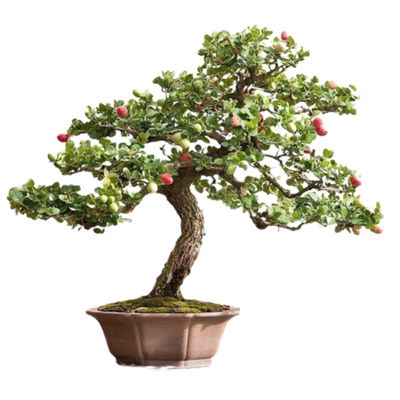
Hardiness zone : 9 – 11
Bonsai Styles : Informal upright, cascade
Country of Origin : South Africa
Natal plum is a dwarf evergreen tropical shrub native to South Africa. It has thick waxy leaves, strong thorns, fragrant white flowers reminiscent of gardenia, and edible red plum-like fruits.
It is a thorny bush with small leaves. Remember that it will only produce flowers if kept in a sufficiently bright room.
The Natal plum is an excellent choice for bonsai beginners since it’s easy to grow and not particularly fussy. It is drought resistant and likes high humidity levels.
Please read Natal Plum bonsai tree for a detailed guide on how to take care of this bonsai.
54. New Zealand tea tree (Leptospermum scoparium)

Hardiness zone : 9 – 10
Bonsai Styles : Informal upright, formal upright, Slanting
Country of Origin : Australia, New Zealand
New Zealand tea tree, also known as evergreen manuka or Australian Myrtle, is a shrub or small tree that is native to Australia, New Zealand, and Malaysia.
This is an ornamental shrub that has small, lanceolate, bluish-green leaves that are arranged alternately. The flowers range from white to dark red in color and are produced in summer.
Bonsai displays often feature New Zealand tea trees. The small bush has tiny sharp leaves and white to pink button-sized flowers, making it an attractive bonsai plant.
Please read New Zealand tea tree bonsai for a detailed guide on how to take care of this bonsai.
55. Paper flower (Bougainvillea)
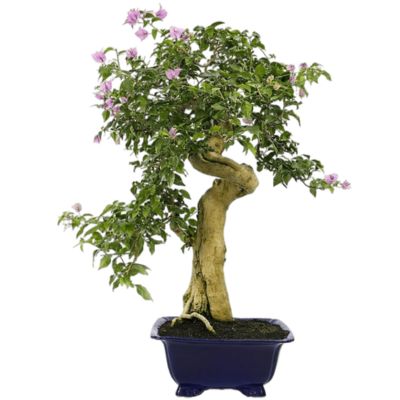
Hardiness zone : 9 – 10
Bonsai Styles : Informal upright, formal upright, Slanting
Country of Origin : Australia, New Zealand
Bougainvillea is a sub-tropical, semi-evergreen woody climber in the southern hemisphere, most commonly from South America.
It has tiny white flowers surrounded by spectacular bracts in various shades of red, purple, and white. These bracts are often mistaken for petals, whose function they also perform, although they are more durable.
The most common species that are used to make bonsai are Bougainvillea glabra and Bougainvillea spectabilis. Older plants have a light beige trunk. It has pointed, smooth-edged, green leaves that are arranged alternately.
It can be cultivated as a deciduous or semi-deciduous plant depending on how the temperature is regulated indoors. Although a climber, when grown as an indoor bonsai it forms a thick trunk.
Please read Bougainvillea bonsai tree for a detailed guide on how to take care of this bonsai.
56. Pink Powder-puff (Calliandra surinamensis / Calliandra Surinam)
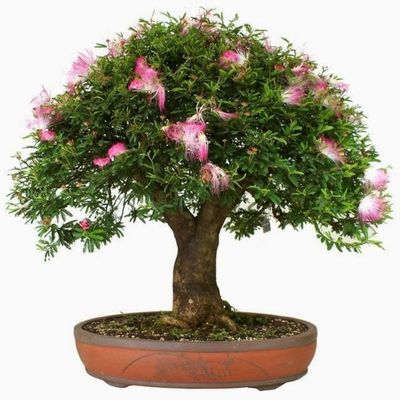
Hardiness zone : 9 – 11
Bonsai Styles : Informal upright, Formal upright
Country of Origin : South America
The dense foliage, abundant branches, ease of growing in pots and speedy growth of this South American native make it an excellent small to medium bonsai. It is also known as Surinam Powder-Puff or Rose Cascade.
It is a mimosa-like low branching shrub. This plant has evergreen, pinnate, dark green and oblong leaves.
As the name suggests, the plant produces pink colored flowers that look like “powder puffs”. As an indoor bonsai they do best in a warm, sunny window site.
Please read Pink Powder-puff bonsai tree for a detailed guide on how to take care of this bonsai.
57. Pistachio (Pistacia lentiscus) – aka mastic tree

Hardiness zone : 9 – 11
Bonsai Styles : Broom and Upright informal
Country of Origin : Mediterranean, Far east countries, Korea, China
The mastic tree probably originated in central Asia, but it has been known for many thousands of years in the Middle East and the eastern Mediterranean region—particularly for its fruit, the pistachio nut.
The Mastic tree is an evergreen shrub or, more rarely, a small tree.
The bark is brown and scaly, the alternate, pinnate leaves have blunt-tipped, oval leaflets, the monoecious flowers are in axillary racemes, and the clusters of drupes are red, turning black when ripe.
Pistacia lentiscus bonsai care is very simple; the small tree requires little attention. When the conditions in the room are suitable, a mastic tree can be considered an easy plant, suitable for a bonsai beginner.
Please read mastic tree bonsai for a detailed guide on how to take care of this bonsai.
58. Pomegranate (Punica granatum)

Hardiness zone : 8 – 10 (Punica granatum) & 7 – 11 (Punica granatum ‘Nana’)
Bonsai Styles : Informal upright, semi-cascade, twin trunk, group, raft, root-over-rock
Country of Origin : Eastern Mediterranean, South Asia
Punica granatum is an excellent small deciduous tree, suitable for indoor bonsai in either a cold or warm room. It also has a dwarf variety called Punica granatum ‘Nana’, which is also highly suitable for making bonsai. In fact, the smaller flowers and fruit of the dwarf variety make the dwarf variety more preferable to bonsai enthusiasts. These small fruits are not edible.
The thorny branches of the tree produces oblong to lanceolate leaves that in their native habitat become very robust.
The flowers on the pomegranate are red in color and tubular in shape, emerging during the months between June and September.
For making flowering bonsai trees, pomegranate trees are especially recommended.
Please read Pomegranate bonsai tree and Dwarf Pomegranate bonsai tree for a detailed guide on how to take care of this bonsai.
59. Queensland Bottle tree (Sterculia rupestris / Brachychiton rupestris)

Hardiness zone : 9 – 11
Bonsai Styles : Informal upright, group
Country of Origin : Australia
It is also known as Bottle tree, narrow-leaved bottle tree, kurrajong or Australian bottle tree.
The tree originated in the Australian deserts. It can be categorized as subtropical to tropical. It is an evergreen tree with a bottle-like trunk and roots that store water.
On its long leaf stalk, it has 5-7 dark green lobed leaves. As an indoor bonsai, it may not flower.
Please read Queensland Bottle tree bonsai for a detailed guide on how to take care of this bonsai.
60. Red Powder-Puff (Calliandra haematocephala)
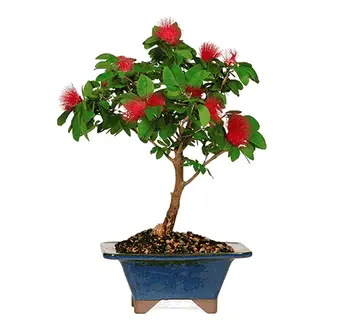
Hardiness zone : 9 – 11
Bonsai Styles : Informal upright, Formal upright, semi-cascade, cascade, clump
Country of Origin : South America
Calliandra haematocephala is a small, evergreen shrub with scented, double-feathered green leaves that close up during the night and when the plant experiences drought.
The flower buds, which develop from late spring through summer, look like raspberries and grow from the leaf axils. It grows red powder puff-like flowers. From the flowers, leathery leguminous fruits emerge.
The trunk of the young plant is light grey, turning dark grey to almost black with age.
Please read Red Powder Puff bonsai tree for a detailed guide on how to take care of this bonsai.
61. Rosemary (Rosmarinus officinalis)
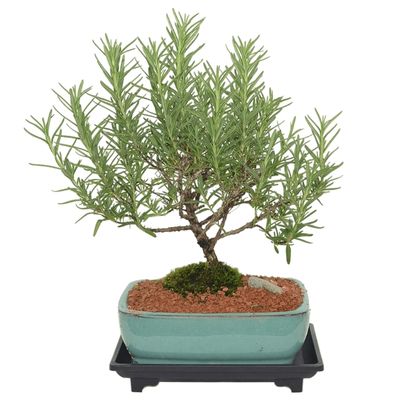
Hardiness zone : 7 – 10
Bonsai Styles : Broom
Country of Origin : Mediterranean
This evergreen, aromatic herb can also be cultivated as an indoor bonsai. Wild Rosemary has needle-shaped, green leaves and small whitish-blue or mauve flowers in spring.
It is a vigorous grower if placed in a bright south-facing window.
The rosemary bonsai is suitable for all types of bonsai enthusiasts : people who admire intriguing bark textures, because it quickly grows a rough- fissured, ancient-looking trunk; lovers of flowers, who can enjoy its profuse small blue flowers from spring through summer; and those who enjoy the scent of the narrow leaves.
For stylists the small-size leaves and tight growth as well as its vigor make rosemary suitable for all sizes and styles of bonsai.
Please read Rosemary bonsai tree for a detailed guide on how to take care of this bonsai.
62. Sageretia (Sageretia theezans / Sageretia thea)

Hardiness zone : 5 – 8
Bonsai Styles : Formal upright, informal upright, multi-trunk, slanting, semi-cascade, cascade
Country of Origin : Southern Asia
Earlier this plant was known as Sageretia theezans, but now it is known as Sageretia thea.
It is a tropical, evergreen shrub with small, shiny, oval-shaped, light green leaves and a fascinating, strikingly flecked bark, similar to the bark of a tree in the wild. It is a prolific grower, perfectly suited to bonsai training and to being kept indoors.
The trunk has smooth peeling bark with contrasting dark and light brown patches. If the plant is not pruned regularly, it can also sometimes produce small clusters of white flowers.
Sageretia plants are one of the most frequently grown indoor bonsai plants.
Please read Sageretia bonsai tree for a detailed guide on how to take care of this bonsai.
63. Silver Wattle (Acacia dealbata)

Hardiness zone : 7 – 11
Bonsai Styles : Informal upright, Slanting, broom, clump, group, cascade
Country of Origin : Australia
An evergreen tree that bears small silver-green leaves in neat rows on opposite sides of its branches. The yellow flowers, which are tiny with restricted petals, are grouped together in globe-like clusters.
It is also known as the Mimosa. Despite its name, it should not be confused with Albizia julibrissin, also known as the mimosa tree.
Other acacia species that can be used to grow an indoor bonsai tree are: Acacia baileyana (Cootamundra Wattle, Golden Mimosa), Acacia julibrissin.
It needs plenty of light and an airy location. If raised indoors, keep them in a bright, airy place, with a temperature of not more than 64°F (18°C).
Please read Acacia bonsai tree for a detailed guide on how to take care of this bonsai.
64. Sim’s azalea (Rhododendron simsii)

Hardiness zone : 7 – 11
Bonsai Styles : Informal upright, Slanting, broom, clump, group, cascade
Country of Origin : Australia
This compact little bush comes from the humid regions of southern China. Sim’s azalea is an evergreen, beautifully-colored, flowering shrub.
They have small, shiny, pointed leaves that range from light to dark green in color. It also produces clusters of single or double pink, white, crimson or red flowers that bloom between mid-autumn and mid-spring.
Please read Sim’s azalea bonsai tree for a detailed guide on how to take care of this bonsai.
65. Singapore Holly (Malpighia coccigera)

Hardiness zone : 10 – 11
Bonsai Styles : Formal upright, informal upright, slanting, semi-cascade, clump, Broom
Country of Origin : West Indies
Singapore holly is a small, often prostrate, thorny, evergreen shrub. The plant has pear-shaped, tough-textured, pale green leaves with spine-toothed edges. Leaves are glossy on top and are arranged alternately.
It produces a large number of small pink or lilac flowers in summer. These flowers are followed by tiny round berries.
Growing this plant as an indoor bonsai is not easy, and it requires special care to survive. Hence, bonsai beginners should avoid this plant.
Please read Singapore Holly bonsai tree for a detailed guide on how to take care of this bonsai.
66. Strawberry Guava (Psidium cattleianum / Psidium cattleyanum / Psidium littorale)
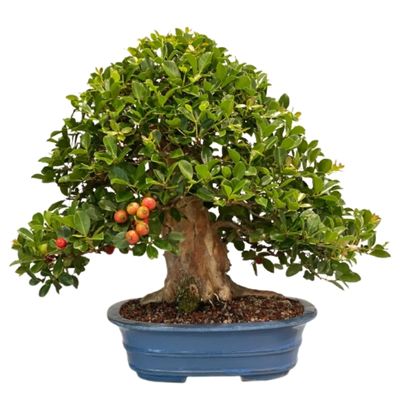
Hardiness zone : 8 – 11
Bonsai Styles : Informal upright, wind-swept
Country of Origin : Brazil
Strawberry guava is a fast-growing, tropical bush with attractive cinnamon-colored bark that peels away from its light-colored under-bark.
It produces delicate white flowers with multiple stamens that lead to beautiful and edible red fruit. It also has somewhat large dark green alternate oval leaves, and new spring growth in an attractive shade of red.
Strawberry guava is suitable for making medium to large bonsai trees because of its large leaves. It may need severe pruning at times to keep it at a manageable size.
The strawberry guava bonsai can be kept at warm temperatures over winter and needs a bright location.
Please read Strawberry Guava bonsai tree for a detailed guide on how to take care of this bonsai.
67. Strawberry tree (Arbutus unedo)
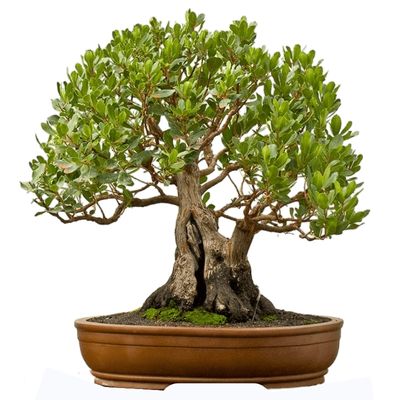
Hardiness zone : 7 – 10
Bonsai Styles : Informal upright, formal upright, broom, twin-trunk, clump
Country of Origin : Mediterranean
The strawberry tree is a typical constituent of Mediterranean flora, with simple, alternate, persistent, leathery, serrate leaves, and a reddish-brown trunk and branches with bark that flakes off in thin strips at maturity.
The strawberry tree is an ornamental evergreen native to the Mediterranean region, with dark glossy oval leaves that have finely toothed edges.
In the fall, it bears clusters of small white bell-shaped flowers that develop into round strawberry-like fruits no larger than an inch in diameter. A strawberry tree bonsai may have flowers and fruit simultaneously. It will tolerate periods of below-freezing temperatures, although this may prevent fruiting.
The tree’s peeling, rust-colored bark makes a striking contrast to its shiny green leaves. It needs very bright light indoors.
Please read Strawberry tree bonsai for a detailed guide on how to take care of this bonsai.
68. Tamarind (Tamarindus indica)
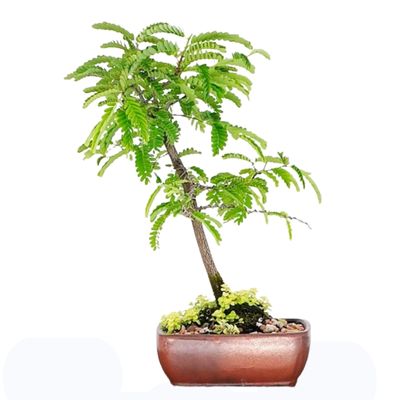
Hardiness zone : 10 – 11
Bonsai Styles : Informal upright, group, slanting
Country of Origin : India
The tamarind tree is a large tropical evergreen tree with small pale green alternate leaves resembling those of the mimosa. They are delicate, and tend to react to drought by dropping. The light green, scented leaves are divided into 20 to 30 pairs of feathery leaflets.
This tree has a strong trunk and thin, rough bark. The beautiful, orchid-like flowers are yellowish with red markings. However, when grown as an indoor bonsai, do not expect these flowers. When properly cared for, it is an ideal material for a bonsai.
Please read Tamarind bonsai tree for a detailed guide on how to take care of this bonsai.
69. Tea olive (Osmanthus fragrans)

Hardiness zone : 8 – 10
Bonsai Styles : Informal upright, multi-trunk
Country of Origin : China and Japan
Tea olive tree, a slow-growing evergreen shrub, is mainly grown as a bonsai for its extremely fragrant clusters of small flowers. These flowers are produced from fall to spring. The flowers range from white to yellow in color.
The leaves of the plant are oval, glossy and dark green.
Tea olive makes an attractive bonsai with its light yellow flowers against a backdrop of its green leaves and beautiful gray bark.
Please read Tea olive bonsai tree for a detailed guide on how to take care of this bonsai.
70. Texas Ebony (Ebenopsis ebano)
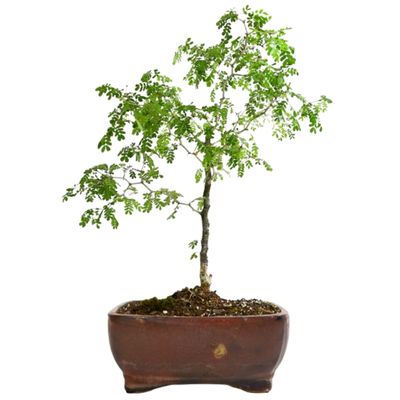
Hardiness zone : 8 – 11
Bonsai Styles : All the bonsai styles. Except cascade
Country of Origin : United States
Southern Texas and Mexico are the native habitats of the Texas ebony. It’s a large shrub or small tree with broad leaves. It is a rounded top tree with dense, dark green foliage.
Leaflets are one-eighth to one-quarter inch, round, arranged feather-fashion on small twigs, usually three to five pairs of leaflets on each 2 to 3 inch twig. Leaves fold up and droop at night and on dark days, even indoors when under lights.
Texas ebony blooms once a year. Blooms are golden puffs in spikes followed by bean-like seedpods.
It is one of the easiest plants to work with as it endures neglect and adapts to low light—although full sun is preferred. A tropical bonsai tree, Texas ebony will not tolerate temperatures below 32°F.
Please read Texas Ebony bonsai tree for a detailed guide on how to take care of this bonsai.
71. Tree of a Thousand Stars (Serissa foetida)
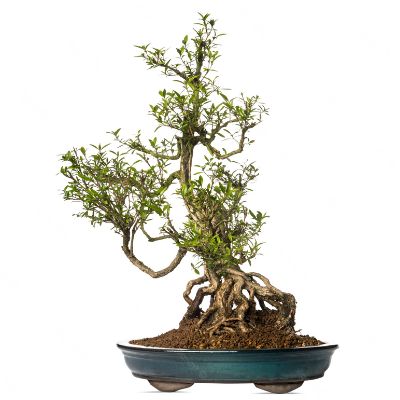
Hardiness zone : 10 – 11
Bonsai Styles : Informal upright, group, slanting
Country of Origin : India
Serissa foetida is a tender, densely branched evergreen shrub that is one of the most favored species for indoor bonsai in the West. It is also a famous outdoor bonsai tree in China, Japan and Southeast Asia, where it has its origins.
The natural color of the trunk is grey, and the bark becomes rougher with age, turning white in older specimens. It has small, lance-shaped, smooth dark green leaves that are toxic when crushed (same as the roots).
In late spring small white flowers cover the tree, and the blooming continues for several months. Sometimes it flowers out of season, owing to the conditions under which it is kept. The flowers are usually single, but double-flowering varieties are also present. The flowers are produced in profusion, hence the name of the tree – Tree of a Thousand Stars.
The tree naturally produces many branches, and this makes shaping easy when grown as a bonsai.
Do Bonsai trees do well indoors?
Bonsai trees can do well indoors, however it depends on the specific species of tree and the indoor environment in which they are placed. For example, Ficus varieties and Chinese Elm are able to thrive in an indoor environment if they receive adequate light, humidity, and water. On the other hand, maples, junipers and pines are not suitable to be grown as indoor bonsai trees.
It is critical to note that indoor bonsai trees, like all plants, require proper care and attention to maintain their health and beauty. Please read indoor bonsai tree care to know how to keep your indoor bonsai healthy.
How long do Bonsai trees last indoors?
The lifespan of a Bonsai tree indoors can vary depending on a number of factors, including the species of tree, the care it receives, experience of the bonsai grower, and the environment in which it is placed. Some Bonsai trees can live for many years indoors, while others may have a shorter lifespan. The care of the indoor bonsai generally dictates how long your indoor bonsai tree will live. Some can even live for 100 years. Also, some indoor bonsai tree varieties such as Monterey cypress, bloodwood tree, and Singapore Holly need more skill and experience and if grown by bonsai beginners, may not live their full life span.
To increase the lifespan of an indoor bonsai, factor such as natural age of the species of the tree can not be controlled. However, other factors such as care and environment can be modified.
Do indoor bonsai trees go dormant?
Bonsai trees can go dormant, even when grown indoors. However, the timing and duration of dormancy may vary depending on the species of tree and the environment in which it is grown.
Ficus, or Chinese elm, may become dormant or undergo through periods of rest or slow growth during the winter months when light levels are lower and temperatures are cooler.
Do indoor bonsai trees attract bugs?
Indoor Bonsai trees can attract bugs, just like any other indoor plant, but this is not always the case. Some of the most common pests that can affect indoor Bonsai trees include spider mites, mealybugs, and scale insects. Please read bonsai pest and diseases and how to keep your bonsai tree pest free to know all about bugs of bonsai trees.
Do indoor bonsai trees need sunlight?
The need of sunlight of an indoor bonsai tree varies from species to species. For example, jade or umrella tree can easily thrive indoors without any direct sunlight. On the other hand, trees like Chinese elm, campache or common olives will be requred to be kept in areas with bright sunlight. Please read light levels required by indoor bonsai to know more about light requirements of various indoor bonsai trees. You can even use grow lights indoors. Please read use led grow lights to grow bonsai indoors.
Why is my indoor bonsai losing leaves?
There can be many reasons behind your indoor bonsai loosing leaves : Insufficient light, insufficient watering, over or under feeding, low temperature or pest and diseases.
How big do indoor bonsai trees get?
Various factors determine how big your indoor bonsai can become, such as: The species and natural growth habit of the tree, the pot size and root conditions and overall pruning frequency. Remember, that the bonsai trees are intensionally kept small. The bonsai grower has all the control over how big an indoor bonsai tree will get.
For your refrence, some indoor bonsai trees, such as the Dwarf Jade (Portulacaria afra), can reach a maximum height of around 3 feet (91 cm) when fully grown, while others, such as the Ficus Retusa (Banyan Fig), can grow up to 6 feet (183 cm) tall.
Is a bonsai tree an indoor plant?
Bonsai trees can be either indoor or outdoor plants, depending on the species and the climate they are grown in. Some species of bonsai trees, such as the Ficus Retusa or the Chinese Elm, can be grown successfully as indoor plants in a bright, well-lit location. Other species, such as the Japanese Maple or the Pine, require outdoor growing conditions in order to thrive. TIpically, tropical and sub-tropical trees are indoor bonsai trees.
When choosing a bonsai tree, it’s important to consider the species, the growing conditions it requires, and the environment in which it will be grown. If you plan to grow your bonsai tree indoors, make sure to choose a species that is well-suited to indoor growing conditions and that you provide it with appropriate care, including adequate light, humidity, and watering.
Are bonsai trees hard to grow indoors?
The level of challenge you will face while growing an indoor bonsai depends on the type of indoor bonsai tree. Some tree varieties can easily handle occasional neglect and can easily adjust to the low light levels of an average home. While some tree varieties are very particular about their surrounding environment and may deteriorate or even die if there is slight variation in care and maintenance. For example, trees like jade, elephant bush, Hawaiian umbrella, and Japanese pepper are not challenging to grow as an indoor bonsai. However, trees like Singapore holly, Monterey cypress, Harland boxwood etc are very challenging to grow for bonsai beginners.
One of the most important factors in growing indoor bonsai trees is providing them with sufficient light. Most bonsai trees require bright, indirect light in order to grow and develop properly.
Another important consideration is humidity. Many indoor environments are quite dry, which can be detrimental to bonsai trees. It’s important to maintain a humid environment around the tree, either through regular misting, using a humidifier, or placing the tree on a humidity tray.
Finally, proper watering and fertilization are key to keeping bonsai trees healthy and thriving. It’s important to monitor the soil moisture and adjust watering accordingly, as overwatering or underwatering can both be harmful to the tree. Fertilizing the tree regularly can help ensure it receives the nutrients it needs to grow and develop properly.
Read how to take care of your indoor bonsai tree for more details.

